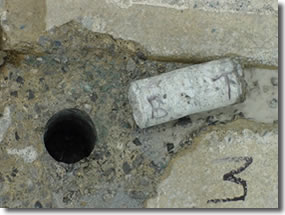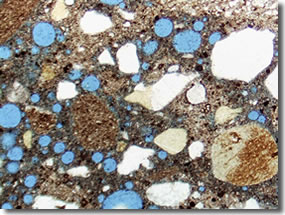Petrographic Analysis of Concrete Structures
Petrography (microscopic analysis) of concrete can reveal defects in its composition and in the way it was placed. Concrete contains aggregate grains that are a subequal mixture of limestone, granitics, and argillaceous (low-grade metasedimentary) fragments. It also contains entrained air bubbles that can be counted.
 Concrete core from a sidewalk that had been improperly cured at subzero temperatures |
 A microscopic view of polished concrete often reveals problems in its makeup and placement |
There are three major groups of aggregate grain types: crystalline (mostly granitics with related coarse-grained minerals such as quartz, potassium feldspar, and plagioclase feldspar); carbonate (skeletal limestones and some recrystallized dolomites); and metasedimentary (mostly low-grade slates and argillites, clay-rich, in some cases silty or sandy). Carbonate grains tend to be rather large (gravel-sized), while most quartz and feldspar grains are of fine to medium sand size (100-500 microns). A number of heavy minerals (primarily garnet and amphibole) are present as part of the crystalline rock population; a few large chert grains (silicified skeletal limestones) were noted as well.